Maximus DCVG Holiday Detector Set by DCVG Ltd.

- Complete D.C Voltage Gradient Equipment with GPS
-
Description
D.C. Voltage Gradient (DCVG) Equipment manufactured by us in UK to military specifications comes complete with everything except a DC power supply needed to survey a buried pipeline using this technique. The equipment which is a direct descendant of the original work carried out in Australia with inventor, John Mulvaney, is packed into protective carry cases and has two main components, the Interrupter and the Survey Meter. During manufacture maximum emphasis has been placed on quality and robustness of construction, with the equipment kept as simple and as flexible as possible. Although the equipment comes with an instruction booklet , a very comprehensive Training Course is available to ensure operators know how to gather data, use and interpret results in order to gain maximum benefit from the technology transfer process. Twenty four years experience in designing, building, using, analysing the data and most important of all, the excavation of several thousand DCVG coating fault indications personally witnessed, gives us, as the suppliers of this equipment, unparalleled expertise in DC Voltage Gradient Technology and its interpretation which is transferred to operators through the detailed training course.
The next evolution of the DCVG Meter has arrived. Our new DCVG Buried Pipeline Coating Survey Instrument combines the advantages of the analogue display with the convenience of sub-metre accuracy GPS and data logging. Designed for reliability and ease of use, this turnkey system can be mastered in minutes and used all day long.
- simple single button push logging of areas of interest.
- continuous high-accuracy position logging records your pipeline’s routeas you survey.
- operated in conjunction with satellite syncrhronised Interrupters
- large, clear meter readout for precise defect location.
- specific Test Post, Coating Fault and Feature recording.
- high speed USB download.
- up to two Gigabytes internal storage.
- 2700mAh batteries give extended surveying time.
- bespoke data download software makes light work of data retrieval and processing.
Audible signal when logging Data. Status of GPS LED. Blank when no GPS signal. Flashing when GPS Signal not valid. Solid light when GPS signal is valid. The backpack carries the GPS aerial, the DGPS Electronics and the battery used to drive the DGPS System. The GPS system requires the logging onto a local base station or the purchase of satellite time for the most accurate location, proven to be 10 to 15 cm.
Some spare parts inter - changeable with our simple Analogue DCVG and our Quantum CIPS.
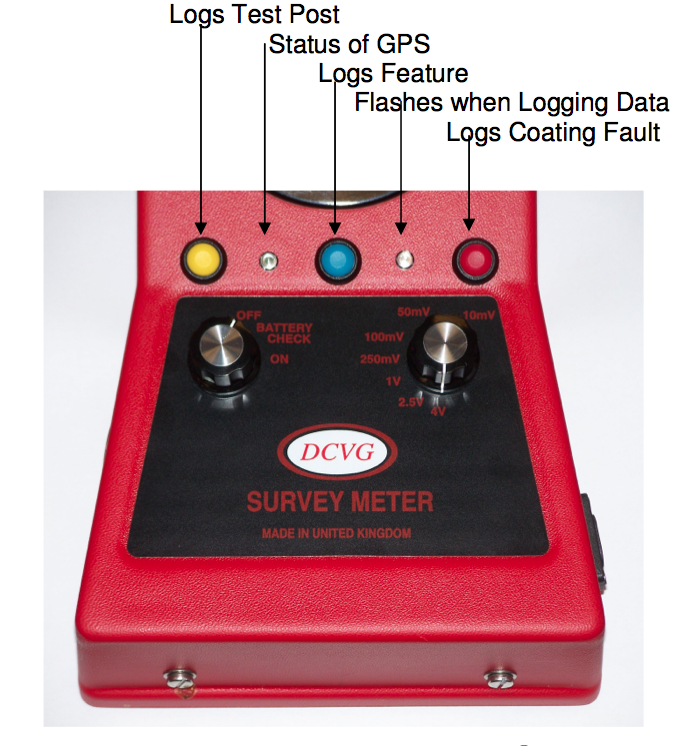
Features
Rugged, Simple, Accurate Location of Faults to Within cm
- USB-2 Compatible (Fast Download)
- Up to 10 Volt Analogue Range
- Analogue and Digital Read-out
- AC mains rejection filtering
- GPS Automatic logging
- Store Multiple Surveys
- 2 GB Internet Memory
- Water Resistant
-
Contents
Maximus Full DCVG Set
Item Number Maximus DCVG Set - Item Quantity 1 Maximus DCVG Survey Meter with Leather Straps 1 2 Maximus DCVG Satellite Aerial 1 3 50 Amp Satellite Synchronisable Interrupter of 125 amp Satellite Synchronisable Interrupter 1 4 Interrupter Satellite Aerial 1 5 Power Cable to External 12 Volt Battery 1 6 Bias Prove Handle 1 7 Double Connector Handle 1 8 120/240 Volt Battery Charger 1 9 3-Way Battery Charger Adaptor Lead 1 10 Right Hand Connection Lead 1 11 Left Hand Connection Lead 1 12 15 Metre Remote Earth Cable 1 13 Jar of Copper Sulphate 1 14 Porobe Filler Bottle 1 15 Probe Tips 6 16 Probe Tip Washers 6 17 Probe Tip Holder 3 18 PTFE Seasling Tape 1 19 Referecne Porbes -DCVG 2 20 Reference Probe Carry Case 1 21 Equipment Carry Case with Blue Insert 1 22 DCVG User Manual 1 23 DCVG Maintence Manual 1 24 DCVG Interrupter Manual 1 25 Packing List in Documents Folder 1 26 Certificate of Origins in Documents Folder 1 27 Certificate of Calibration & Equipment Test in Documents Folder 1 28 Guarantee in Documents Folder 1 29 Certificate of Conformity & Traceability in Documents Folder 1 30 Certificate of Quality in Documents Folder 1 Maximus Basic DCVG Set
Item Number Maximus Basic DCVG Set Quantity 1 Maximus DCVG Survey Meter 1 2 Maximus DCVG Satellite Aerial 1 3 50 or 125 Amp Satellite Synchronisable Interrupter 1 4 Interrupter Satellite Aerial 1 5 Power Cable to External 12 Volat Battery 1 6 Bias Probe Handle 1 7 Double Connector Handle 1 8 120/240 Volat Battery Chareger 1 9 3-Way Battrery Charger Adaptror Lead 1 10 Right Hand Connectin Lead 1 11 Left Hand Connection Lead 1 12 15 Metre Remote Earth Cable 1 13 Mini USB Cable 1 14 Har of Copper Sulphate 1 15 Probe Filler Bottle 1 16 Probe Tips 6 17 Probe Tip Washers 6 18 Probe Tip Holder 3 19 PTFE Sealing Tape 1 20 Equpment Carry Case with Blue Insert 1 21 Maximus DCVG User Manual 1 22 Maximus Quick Start Guide 1 23 DCVG Maintenance Manual 1 24 Interrupt Manual 1 -
History
Principle of the DC Voltage Gradient Technique
In Cathodic Protection when current flows through the resistive soil to the bare steel exposed at faults in the protective coating, a voltage gradient is generated in the soil. The larger the fault the greater the current flow and hence voltage gradient and this is utilised in the technique to prioritise faults for repair. The voltage gradient is observed by measuring the out of balance between two copper sulphate electrodes utilising a specially designed milli-voltmeter. When the two electrodes are placed 1.5 meters apart on the soil in the voltage gradient from a coating fault, one electrode adopts a more positive potential than the other which allows the direction of current flow to be established and fault to be located. To simplify the fault location interpretation, the applied CP is separated from all other DC influences such as Tellurics, DC Traction etc, by pulsing the local CP ON and OFF in an unsymmetrical fashion. The pulsing DC can be from the pipeline CP system itself, or from an independent source such as a portable DC generator or batteries utilising a temporary groundbed and impressed on top of a pipelines existing CP system.
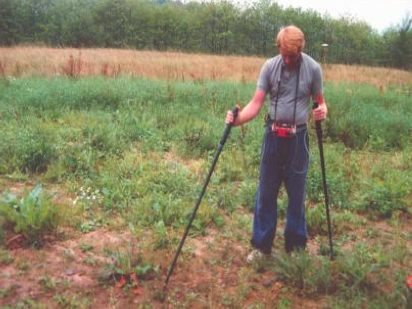
In surveying a pipeline, the operator walks the pipeline route testing for a pulsing voltage gradient at regular intervals. As a fault is approached, the surveyor will observe the milli-voltmeter needle begin to respond to the pulse, pointing in the direction of current flow
that is towards the fault.When the fault is passed the needle direction completely reverses and slowly decreases as the surveyor moves away from the fault. By retracing to the fault, a position of the electrodes can be found where the needle shows no deflection in either direction (a null). The fault is then sited midway between the two electrodes. This procedure isthen repeated at right angles to thefirst set of observations, and where the two midway positions cross is the epicentre of the voltage gradient. This is usually directly above the coating fault.
In order to determine various characteristics about a fault, such as severity, shape, corrosion behaviour, etc, various electrical measurements around the epicentre and from epicentre to earth are made for interpretation.
The beauty of the DCVG technique is that it utilises the existing pipeline CP system at its normal setting wherever possible and hence results reflect the intimate interaction between the protective coating degradation and the effectiveness of CP at individual coating faults. This is very powerful information in the fight against corrosion. No AC or Electromagnetic Technique offers such a direct study capability.
The DCVG Technique can be applied in City Streets, Process Plant and Refineries, across Rivers and Estuaries, Swamps, Parallel Pipeline systems, to Gas, Oil, Chemical and Water Pipelines. Also DCVG can be used to evaluate the protective coating on Telephone and Power Cables.
-
ECDA Data Analysis
Not every coating fault or metal loss location requires repair. In practice, for most pipelines, 99+% of all coating faults have no metal loss but there is the potential for metal loss if there is a coating fault with weak CP in low resistivity soil. While the repair of critical metal loss is important, most pipelines are rehabilitated on the basis of the need to improve the protective coating in order to make the CP more effective. Remember, in line inspection tools detect the symptom of the problem. DCVG equipment, when combined with potential measurements, detect the real cause of the problem that leads to metal loss, which is a breakdown in corrosion control through coating failure and an inadequate CP system.
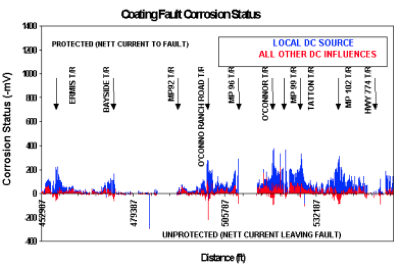
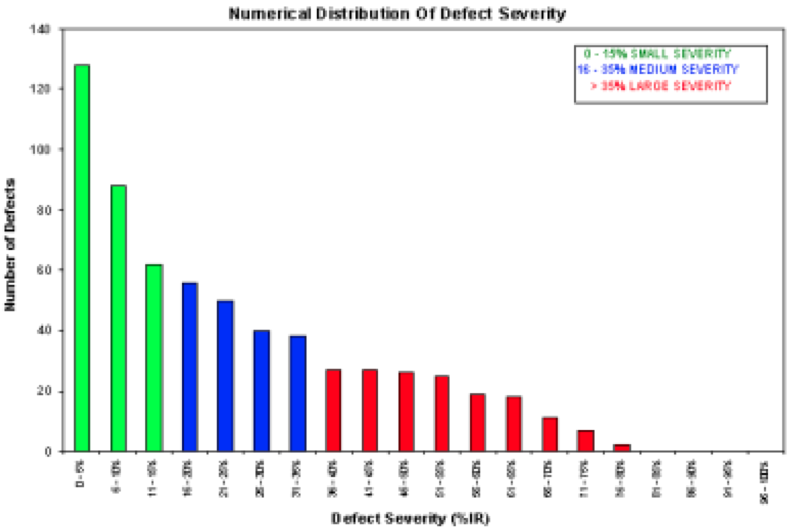
There is never enough money to repair all coating faults. Detailed analysis of data is required to identify large, current consuming coating faults, particularly those in low soil resistivity areas. These coating faults should be repaired releasing CP current that then becomes available to improve protection of those faults not identified for repair.
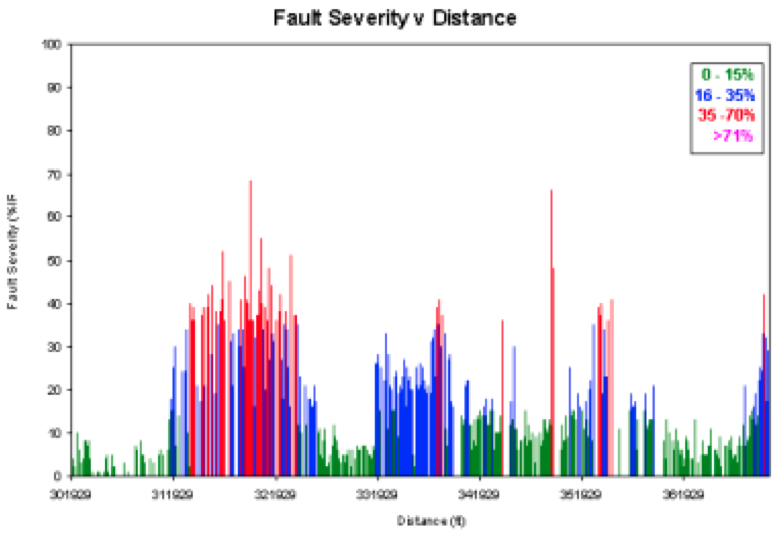
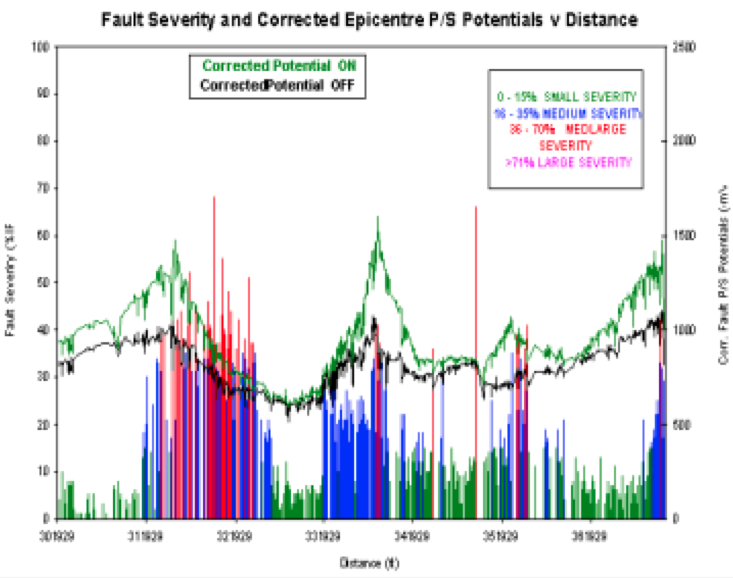
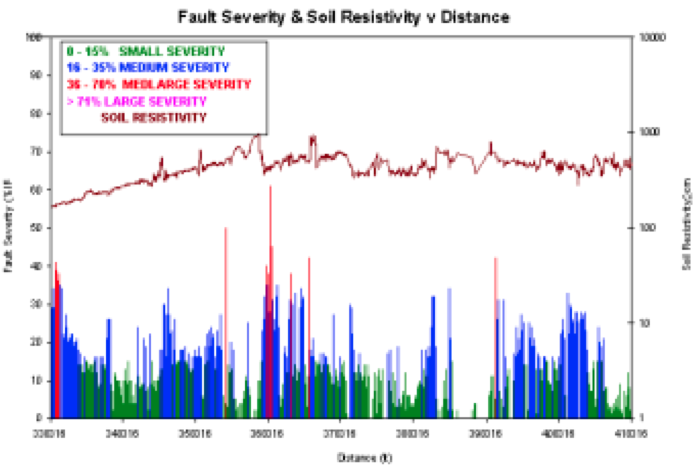
-
Properties
What Are The Properties Of A Coating Fault That We Should Measure?
The collection and analysis of the correct information is important to make your Pipeline Integrity Activities both cost and technically effective. Identified in this table in order of priority are the properties of coating faults that need to be measured to provide data for the best subsequent analysis.
Properties of a Coating Fault Required for Proper Fault Analysis
PRIORITY
PROPERTY
TECHNIQUE USED
1
Fault Cathodic Current
DCVG
2
Fault Anodic Current
DCVG
3
Net Current Flow To/From Fault
DCVG
4
Soil Resistivity
EM
5
CIPS OFF potential
CIPS
6
CIPS ON Potential
CIPS
7
DC Interference
DCVG & CIPS
8
AC Interference
Voltmeter
9
Disbondment
Visual/DCVG/ Coating Type
10
Soil pH
pH Meter
11
Type of Soil
Visual
12
Vegetation / Roots
Visual
13
Fault Severity
DCVG
14
Fault Size
Visual on Excavation
15
Location
DCVG/GPS
16
Proximity to Another Fault
DCVG/GPS
17
Overall Density of Faults
DCVG/GPS
18
Type of Coating
Records
19
Field Joint Coating
Records
20
Age of Coating
Records
EM = Electromagnetic Soil Resistivity Measurement.
DCVG = Analogue DC Voltage Gradient Technique. This table does not apply to so called combined digital DCVG/CIPS which is really just lateral CIPS and is a sham technique.
CIPS = Close Interval Potential Survey Technique also known as CIS in North America.
GPS is sub-metre GPS Location and Distance measurement equipment, eg. Trimble Pro XRT
